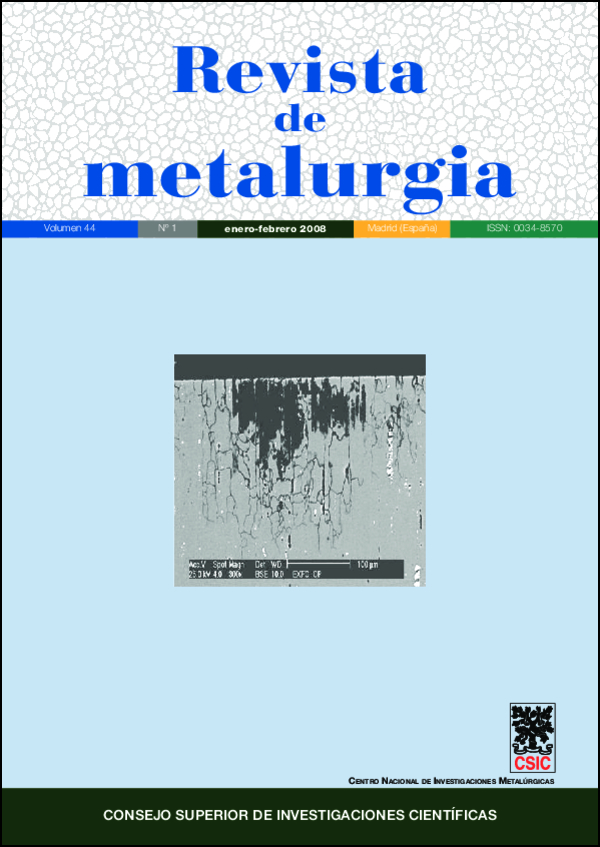Using the ultrasound and instrumented indentation techniques to measure the elastic modulus of engineering materials
DOI:
https://doi.org/10.3989/revmetalm.2008.v44.i1.95Keywords:
Mechanical properties, Nanoindentation, Ultrasound, Poisson’s ratio, Elastic modulusAbstract
Currently, the acoustic and nanoindentation techniques are two of the most used techniques for material elastic modulus measurement. In this article fundamental principles and limitations of both techniques are shown and discussed. Last advances in nanoindentation technique are also reviewed. An experimental study in ceramic, metallic, composite and single crystals was also done. Results shown that ultrasonic technique is capable to provide results in agreement with those reported in literature. However, ultrasonic technique does not allow measuring the elastic modulus of some small samples and single crystals. On the other hand, the nanoindentation technique estimates the elastic modulus values in reasonable agreement with those measured by acoustic methods, particularly in amorphous materials, while in some policristaline materials some deviation from expected values was obtained.
Downloads
References
[1] B.R. Lawn, J. Am. Ceram. Soc. 81 (1998) 1.977-1.994.
[2] W.C. Oliver y G.M. Pharr, J. Mater. Res. 7 (1992) 1.564-1.583.
[3] M.F. Doerner y W.C. Nix, J. Mater. Res. 1 (1986) 601-609. doi:10.1557/JMR.1986.0601
[4] A. Stilwell y D. Tabor, Proc. Phys. Soc. 78 (1961) 169-179. doi:10.1088/0370-1328/78/2/302
[5] G.M. Pharr, W.C. Oliver y F.R. Brotzen, J. Mater. Res. 7 (1992) 613-617. doi:10.1557/JMR.1992.0613
[6] W.C. Oliver y G.M. Pharr, J. Mater. Res. 19 (2004) 3-20. doi:10.1557/jmr.2004.19.1.3
[7] R. B King, Int. J. Solids Struct. 23 (187) 1.657-1.664.
[8] J. Woirgard y J-C. Dargenton, J. Mater. Res. 12 (1996) 2.455-2.458.
[9] M. Troyon y L. Huang, J. Mater. Res. 20 (2005) 610-617. doi:10.1557/JMR.2005.0099
[10] J.M. Meza, M.C. Moré, R.M. Souza, y J. Cruz, Mater. Res. 10 (2007) 437-447. doi:10.1590/S1516-14392007000400019
[11] A. Bolshakov y G.M. Pharr, J. Mater. Res. 13 (1998) 1.049-1.058.
[12] G.M. Pharr, Instrumented indentation testing, Vol. 8, ASM Handbook, Mechanical Testing and Evaluation, 2000. pp. 231-242
[13] A.C. Fischer-Crips, Nanoindentation, Ed. Springer, New York, EE.UU. Primera edición, 2002, pp. 71 y 198.
[14] M.R. Vanlyingham, J. Res. Natl. Inst. Stand. Technol. 108 (2003) 249-265.
[15] K.W. Mcelhaney, J.J. Vlassak, y W.D. Nix, J. Mater. Res. 13 (1998) 1.300-1.306.
[16] G.S. Kino, Acoustic Waves: Devices, Imaging & Analog Signal Processing. Prentice-Hall, New York, EE.UU. 1987, pp. 1-84.
[17] W.P. Mason, Physical Acoustics, Academic Press, Volume 1, New York, EE.UU., 1964, pp. 72-76
[18] E.E. Franco, M.A.B. Andrade, R.T. Higuti, J.C. Adamowski, y F. Buiochi, Proc. Int. Cong. Mech. Eng. COBEM-18, Ouro Preto, MG - Brazil, 2005.
[19] J. Wu, J. Acoust. Soc. Am. 99 (1996) 2.871- 2.875.
[20] Industria e comercio. Brasimet. Propiedades de revestimientos durotin. http://www.brasimet.com.br/durotin/tin1.jpg, 2006.
[21] H.E. Exner, Physical Metallurgy: Qualitative and quantitative surface microscopy metallurgy. Robert Canh y Peter Haasen (Eds.), Elsevier Science, Noruega, 1992, pp. 945-947.
[22] D. Tabor, The Hardness of Solids, Clarendon Press, Oxford, 1951, pp. 14-16.
[23] G. Krauss, Steels: heat treatment and processing principles. Materials Park, OH, Ohio: ASM International, 1990, pp. 210-220.
[24] A.C. Fischer-Cripps, Surf. Coat. Technol. 200 (2006) 4.153-4.165.
[25] J. B. Quinn y G.D. Quinn, J. Mater. Sci. 32 (1997) 4.331-4.346.
[26] V. Domnich y. G. Gogotsi, App. Phys. Lett. 76 (2000) 2.214-2.216.
[27] K.D Bouzakis, N. Michaidili, S. Hadjiyianni, Skordaris y G. Erkens, J. Mater. Char. 49 (2003) 149-156.doi:10.1016/S1044-5803(02)00361-3
[28] N.J.M. Carvalho, Tesis Doctoral, Universidad de Groningen, Noruega, 2001
[29] M. Zhang y J. He, Surf. Coat. Technol. 142 (2001) 125-131. doi:10.1016/S0257-8972(01)01221-X
Downloads
Published
How to Cite
Issue
Section
License
Copyright (c) 2008 Consejo Superior de Investigaciones Científicas (CSIC)

This work is licensed under a Creative Commons Attribution 4.0 International License.
© CSIC. Manuscripts published in both the printed and online versions of this Journal are the property of Consejo Superior de Investigaciones Científicas, and quoting this source is a requirement for any partial or full reproduction.
All contents of this electronic edition, except where otherwise noted, are distributed under a “Creative Commons Attribution 4.0 International” (CC BY 4.0) License. You may read the basic information and the legal text of the license. The indication of the CC BY 4.0 License must be expressly stated in this way when necessary.
Self-archiving in repositories, personal webpages or similar, of any version other than the published by the Editor, is not allowed.
















